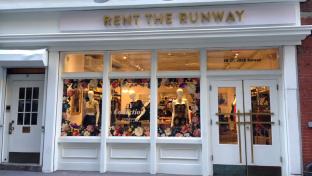Rent the Runway: CTO Josh Builder On How Homegrown Retail Tech Drives its Data-Driven Success
Rent the Runway (RTR) uses homegrown retail technology to give the company control of the customer experience. Since it was co-founded in 2009, RTR has evolved its unique reverse logistics business model from a source for occasion fashion rentals to offering monthly subscription programs. Now the fashion rental retailer's subscription business is up 125% year-over-year and is projected to triple in 2018.
RIS News caught up with chief technology officer Josh Builder for a deep dive into how Rent the Runway relies on proprietary tech for data-driven success:
"We use analytics to tweak all aspects of our model constantly," explains Builder. "From the beginning this has been a data driven technology business with a fashion soul. Learning and data, and using algorithms to impact our experiences, has been part of the DNA of this company from the beginning. "
Builder explains that because the RTR's model is in the reverse logistics business, meaning rental items are always going out and coming back in, the company benefits from being in a "feedback loop" providing RTR a huge opportunity with data and experiences. In addition to this, the company has extreme control over the business and its data because it runs on proprietary retail technology.
"Everything was built from scratch and always has been," says Builder. "From algorithms to the systems that power our warehouse, to all of our customer-facing applications, our data scientist's platform--everything has been built in-house since the beginning."
What drove RTR to make the choice to develop everything in-house? To tackle problems and optimize every aspect of the experience, the retailer felt it had to build its own tech and be able to control it.
"Because of the nuances and complexities of a business where 100% of our items come back to us, it really puts us into a completely separate league from managing data, from managing logistics, from managing warehouse, from managing shipping, from managing customer experience—all of those things become very unique problems in a situation where you're renting as opposed to doing a one-way transaction," explains Builder.
Another reason RTR built its own homegrown tech was to be able to collect data from almost every touchpoint their customers have with RTR, from renting online to becoming a subscriber, to whether or not they're interacting with the retailer in its brick and mortar stores, of which there are five locations. RTR currently manages more than 450,000 pieces of fashion, as well as data points about each of its 8 million member's interactions with the brand.
According to Builder, the fashion rental company recognizes and expects that its users will interact with the retailer in a number of different ways over time. "People's lives change," he notes. For example, a RTR customer might first use the company to rent dresses for a number of weddings, then they might use it for work, then they might use it for maternity clothes as their needs evolve.
"We look to data to help us paint a picture of a user over a period of time," says Builder.
He explains that the retailer needed to be able to know the lifelong path of each customer and "take all of those data points of how someone interacts with us, and then marry it with the larger community of RTR in terms of all of the reviews and interactions people are feeding back to us proactively around how things fit, how they look, what sort of event they went to."
In addition, RTR then marries this data back to the particular item-level rich data they get from running the largest dry cleaning business in the world. They tie the individual garment data back into the user journey.
RTR even uses its vast item-level data to help designers make garments that work better for them. Builder gives an example that one particular fabric might need to be dropped out for another that works better.
"Because RTR has been around now for eight years and has a tremendous amount of historical data, we do a very good job of looking ahead. When we go out to buy inventory," he says, "we can make with high degrees of certainty, predictions of what we think is going to rent with high level of success."
"When we send our buyers out to market, they're not necessarily just using instinct, what they think is going to be cool, they're going armed with a tremendous amount of insight that comes from our historical data and our projections going forward about what they should be looking to acquire."
Using Data and Analytics to Tweak
"One of the luxuries we get by having all of our software built in-house," notes Builder," is we've been able to make sure all of our systems are in constant communication with each other."
In the short term, this allows RTR to use the real-time data they are getting to dynamically change the customer experience in real-time. For example, they can change what inventory they think a customer might like, based on a personalization algorithm or provide recommendations around what clothing item might be better for a particular event.
In the long term, RTR is able to look at the data and see what behavior is occurring over time to "start to shape our programs and offerings around these larger observations and analysis we're getting," he says. "This stuff very much evolves in real-time."
While RTR relies on its own retail tech, the company is migrating to using data warehouse platform Snowflake to help speed insights.
"We've been building all of our applications in-house since the beginning so we did this as well with our data warehouse," illustrates Builder.
In the early days RTR had to do a lot of this itself, from setting up the hosting and managing the infrastructure, to buying more equipment as the business grew-- "all of the things that are a little bit out of style these days because they take a lot of work," he says.
RTR got to a point in the last year where this strategy wasn't going to work for the company's size and its future. Builder says RTR quickly realized another company like Snowflake could help it scale massively and scale on demand (Click here for a video diving into the technical aspects).
Now, with Snowflake, he says "we're in the driver's seat so we can call the shots, which just gives me and my team the ability to think creatively and not be constrained by infrastructure."
"We've done a number of trials over the last year and set things up and are getting ready to go completely live with it," although he notes they are already using the data warehouse platform in a number of aspects.
Editor's Sneak Peek: This retail tech developer will be featured in our March "5 Retailers That Matter" cover story.





